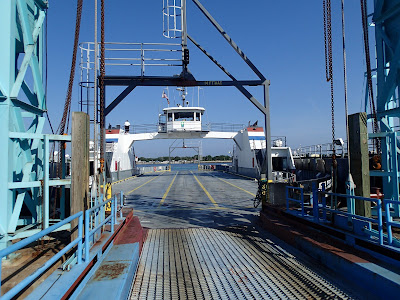Moving on from "Shoe Bay", Douglas and I made our way along the South Channel, staying close to the south coast of Eilean Shona. This is a great area for watching wildlife from a kayak.....
You are pretty much guaranteed close views of seals, the curious younger animals will follow very closely and can be seen through the clear water as they swim under the boats on inspection passes. We also saw several Otters and an Eagle in quick succession during this part of the journey.
There is plenty of historical interest here too, our route took us past Eilean Tioram (the dry island) with the atmospheric ruin of Castle Tioram seeming to grow organically from its rocky form. A tidal island with a rocky outcrop and two accessible small beaches must have been a prime site for operating Birlinns (a light Highland version of the Viking longships) and would have been a natual choice for building a fortification. The present castle is mediaeval, dating from the 13th or 14th century, but it is fairly certain that there was a fortified site on Eilean Tioram long before that.
Douglas and I didn't linger though; we were hopeful of managing to pass through the North Channel before it dried out on the falling tide. Already we were approaching half tide and though it was neaps, we knew it would be a close run thing. An spell of hard paddling into a sneaky breeze got us to the tip of Shona Beag from where we could see that there was water most of the way to the ford. At low water, over a kilometer of sticky mud is exposed either side of the ford - no good for a portage!
We were in luck.... The channel was indeed "closed to shipping" but we had water all the way to the ford and needed to portage only over the ford itself and a couple of meters of mussel shell seabed. If you paddle around Eilean Shona, tidal planning will always be a factor. When I last paddled this channel with Simon and Liz, we planned the passage to drift down gently on the flood tide, enjoying flat calm conditions and autumnal colours. More recently, Douglas and I were prevented from gaining ground in the channel by a very strong headwind, and had to turn around.
Back on the water at the other side of the ford, we enjoyed a gun-barrel view down the channel to the Sgurr of Eigg. The time pressure was now off; we could relax and slow the pace. The North Channel has rocky slopes on either shore and is a really atmospheric place to paddle.
There was very little wind to affect us this time and all too soon we reached the twisting channel leading to the open sea. From seaward, it seems unlikely that Shona is even an island, the channel entrance is hidden and the rocky heights of the island look to be a continuation of the coast itself.
We paddle north a little way to reach a favourite luncheon spot. There was a chilly breeze blowing, but nothing like as cold as when we'd lunched here previously - after I'd taken an unplanned swim!
We took second luncheon of soup accompanied with cheese and houmous wraps, and partook of a small serving of Golden Steadying Liquid to ward off the chill of the breeze.
From here, we paddled south down the cliff-lined west coast of Eilean Shona to complete our circumnavigation.
On the way back to Ardtoe we heard warnings of gales "imminent". Once again we'd managed to snatch a superb day on the water in a narrow window of weater - which seemed to have been the way of things in winter 2012-13.
We both had "interesting" journeys home. Some of the worst snow in northern Scotland is normally in March, and this year was no exception. Douglas' route took him over the exposed Rannoch Moor in a blizzard. My route home crosses the spine of Scotland and I listened to the radio in the car as one potential route home after another was closed due to snow. I had a very difficult time between Grantown on Spey and Tomintoul as the snow whirled down in huge flakes driven by a strong easterly wind, obscuring the road completely at times. Other drivers did double-takes as I passed with a sea kayak on the roof of the car!
Safely home and in front of a blazing log fire, I could reflect on a great short journey and the culmination of a marvellous shared winter of exploration on Scotland's west coast.
Douglas will also tell the story of this trip - starting here with a truly pyrotechnic sunset......






















































